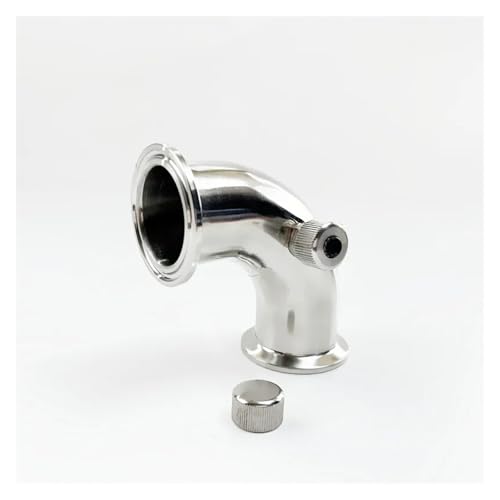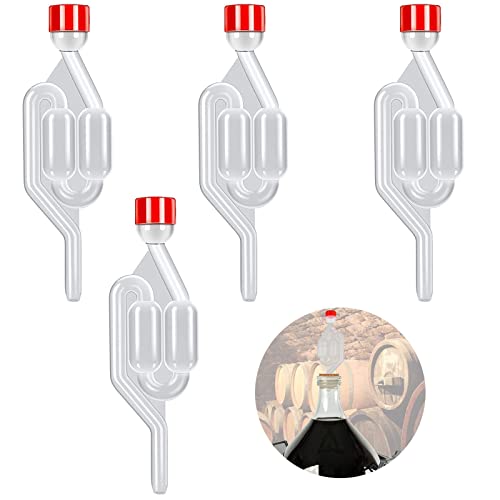You are using an out of date browser. It may not display this or other websites correctly.
You should upgrade or use an alternative browser.
You should upgrade or use an alternative browser.
Switching from aerobic to anaerobic fermentation.
- Thread starter BrowserUk
- Start date

Help Support The Homebrew Forum:
This site may earn a commission from merchant affiliate
links, including eBay, Amazon, and others.
LeithR
Landlord.
What you might be thinking about is what I do.
I brew initially in an open bucket with a loosely fitting lid, this is effectively Aerobic fermentation once you get a couple of inches of foam on top known as Krausen this is the beers initial vigorous fermentation, my practice is once that has settled down I then move the brew carefully into a closed fermenting vessel with an airlock this is Anaerobic fermentation.
Note that you can crop the krausen which is rich in good yeast and re-use the yeast in a further brew known as top cropping.
The benefit that I like about this approach is you can confidently leave the brew in the closed fermenter for quite a long time thus allowing the brew to clear and the yeast to settle before you either bottle or put into a pressure barrel.
I brew initially in an open bucket with a loosely fitting lid, this is effectively Aerobic fermentation once you get a couple of inches of foam on top known as Krausen this is the beers initial vigorous fermentation, my practice is once that has settled down I then move the brew carefully into a closed fermenting vessel with an airlock this is Anaerobic fermentation.
Note that you can crop the krausen which is rich in good yeast and re-use the yeast in a further brew known as top cropping.
The benefit that I like about this approach is you can confidently leave the brew in the closed fermenter for quite a long time thus allowing the brew to clear and the yeast to settle before you either bottle or put into a pressure barrel.
I would say that during the aerobic phase, yeast is predominantly reproducing rather than fermenting but these phases are not distinct for all the cells at the same time.
As soon as fermentation starts a layer of CO2 will shield the yeast from any further O2. This and once any O2 in solution is used up will result in anaerobic fermentation.
As soon as fermentation starts a layer of CO2 will shield the yeast from any further O2. This and once any O2 in solution is used up will result in anaerobic fermentation.
Aleman said:You don't . . . the yeast do
Okay. Here's my dilemma.
I'm currently making a 10ltr batch of Apple wine from 6kilos of mixed apples.
I looked up and read a dozen of more recipes and kinda miix'n'matched between them.
But, one recipe says:
"Cover, set in a warm place for 24 hours, then add yeast and nutrient, cover, and set in a warm place for four days, stirring twice daily. Strain pulp and pour liquor into secondary fermentation vessel and fit with airlock."
Another says: "Keep covered (a bath towel held fast with a large rubber band works well if the primary fermentation vessel doesn't have a lid) and in a warm place for 7-10 days. When the vigorous fermentation of the pulp subsides, strain the juice from the pulp and set aside, then press the juice from the pulp and add to the set-aside liquor. Measure and add 3 lb. sugar per gallon of liquor. Put into carboy or gallon secondary fermentation vessel and fit with airlock. "
Another say: "Add yeast and nutrient, again stir well, cover again, and set in warm place for an additional 24 hours. Strain again into secondary fermentation vessel and fit with airlock"
Another says: " After 24 hours, add yeast and nutrient and cover. Stir daily. When S.G. reaches 1.040 (3-5 days), rack into secondary fermentation vessel and fit airlock."
And those are all from the Jack Keller site. He's a strong advocate of not air-locking the fermenter initially: "However, if a recipe says to start fermentation in a primary, do it. Yeast need oxygen to reproduce rapidly, and for the first two or three days rapid reproduction should be all you want your yeast to do. If you start fermentation under an airlock, you are denying the yeast what they need and may or may not have problems. If you do this and have problems, I don't want to hear about it. If you won't follow my instructions and your wine doesn't like it, then take your problems to someone who recommends starting your fermentation under an airlock -- or whatever else you are doing differently."
But then there are many, many recipes that put the must under airlock straight away. And some that seem to go to extraordinary lengths to keep oxygen away from the must from day 1 right through many rackings to bottling. Even to the extent of purging empty demijohns/carboys with CO2 before racking on.
I guess each of the guys has come up with their own preferences through a combination of experience, reading and hearsay.
As I am just starting out, I'm trying to get a feel for a reliable starting point that won't require 10 years of failures before I hit on one that produces drinkable results :)
So, I guess my question reduces to: When should I stop allowing/deliberately incorporating oxygen into the must and seal things up under an airlock?
Cheers, Buk.
LeithR said:I brew initially in an open bucket with a loosely fitting lid, this is effectively Aerobic fermentation once you get a couple of inches of foam on top known as Krausen this is the beers initial vigorous fermentation, my practice is once that has settled down I then move the brew carefully into a closed fermenting vessel with an airlock this is Anaerobic fermentation.
Indeed. Except I'm doing wine not beer; and I've no idea what, if any difference that makes?

£6.89 (£344.50 / kg)
£7.51 (£375.50 / kg)
2x Mangrove Jack’s Craft Series Mead Yeast M05 (10g)
do-it-at-home

£15.96
£16.99
The Brew Your Own Big Book of Clone Recipes: Featuring 300 Homebrew Recipes from Your Favorite Breweries
Amazon.co.uk

£13.58
Banziaju Wine Making Supplies, 18" Auto Siphon Hose For Water Homebrew Siphon Pump With Tubing And Clamp Clear Wine Siphon For Beer Wine Making Kit
Jian Shi Xian Chao Mei Shang Mao You Xian Gong Si

£32.95
£34.95
DIAH DO IT AT HOME Beer & Wine Making Starter Kit - Basic Equipment - All You Need in One Box Homemade Beer & Wine Home Brewing
do-it-at-home

£14.66 (£147.75 / kg)
Spicy World Tartaric Acid Pure 3.5oz - Top Grade, USP Certified, Food Grade, Vegan - Perfect for Wine Making, Mead
Amazon US

£14.25
£18.99
How to Brew: Everything You Need to Know to Brew Great Beer Every Time
Amazon.co.uk

£437.77
HMCOCOOFM 4L 4" OD119mm * 1.5" OD50.5mm Copper Onion Head For Homebrewing,Thickness 1.5mm (With Thermometer)
weifangguanhuawangluokejiyouxiangongsi

£73.98
Sanitary clamp 2" (51mm) OD64mm Sanitary Tri-Clamp 90-Degree Pipe With Nipple And Electronic Thermometer, Stainless Steel 304 Home brewing(Without Thermometer)
DAN CHENG XIAN PENG SHI DA SHANG MAO DIAN

£10.49 (£349.67 / kg)
£11.96 (£398.67 / kg)
Mangrove Jack 3X ’s Craft Series Mead Yeast M05 (10g)
Almost Off Grid

£63.25
Sanitary clamp 1.5" (38mm) OD50.5mm Sanitary Tri-Clamp 90-Degree Pipe With Nipple And Electronic Thermometer, Stainless Steel 304 Home brewing(Without Thermometer)
DAN CHENG XIAN PENG SHI DA SHANG MAO DIAN

£14.76
Digital Temperature Watch Heating Thermometer Home Brewing Tools for Wine Bottle
B&D DIRECT STORE

£11.95
£14.99
WATER COMPREHENSIVE GUIDE (Brewing Elements): A Comprehensive Guide for Brewers
Amazon.co.uk

£63.25
HJBFZZBD Sanitary clamp 1.5" (38mm) FlangeOD50.5mm Sanitary Tri-Clamp 90-Degree Pipe With Middle Nipple And Electronic Thermometer, Stainless Steel 304 Home brewing(Without Thermometer)
DAN CHENG XIAN PENG SHI DA SHANG MAO DIAN
To answer that question, Ideally you would transfer to under airlock once your yeast has switched from actively reproducing to making alcohol. it's difficult to know when this is happening, but generally once you start to see an active layer of yeast bubbles at the surface, that is a good sign. The other complication with wine is that particularly with coloured fruits you are also extracting colour . .so you need the alcohol to be present to extract colour. However the fruit forms a solid cap over the must protecting the must and alcohol from the oxidative effects of the air. Normally for the darker fruits I go for up to 5 days on the pulp (in a bucket), for white wines, particularly delicate flavoured ones I go for a maximum of 3 days. . . .If it's a juice wine, then I tend to ferment in a winemakers fermenter with the cap off until I see small clumps of yeast and bubbles on the surface . . .then the airlock goes onBrowserUk said:I guess my question reduces to: When should I stop allowing/deliberately incorporating oxygen into the must and seal things up under an airlock?
The only time you need to incorporate oxygen into the must or wort is prior to pitching with the yeast. The yeast will rapidly use the Oxygen in the must / wort to make cell membranes, NOT FOR RESPIRATION (*), indeed until a massive amount of CO2 is being given off the difference in partial pressures of the gasses in the air and wort / must will drive O2 to dissolve into the wort / must . . .the yeast will still use the O2 to make cell membranes which is vital for reproduction . . . Note the ergosterols (membrane precursors) are vital for reproduction NOT The Oxygen as yeast can derive the ergosterols from other source
(*) NOTE : Aerobic (with Oxygen) and Anaerobic (without oxygen) are terms that apply exclusively to respiration NOT cell division. Due to the Crabtree effect YEAST DO NOT RESPIRE AEROBICALLY IF THE LEVEL OF GLUCOSE IN THE WORT / MUST IS GREATER THAN ABOUT 4% - 1.010. NO MATTER WHAT THE OXYGEN CONCENTRATION IS IN THE WORT / MUST
I apologise for shouting to those that are capable of reading my earlier comment
BrowserUk said:As I am just starting out, I'm trying to get a feel for a reliable starting point that won't require 10 years of failures before I hit on one that produces drinkable results :)
I think if any of the methods you've read about were producing anything other than drinkable results, you would not have been reading about them in the first place. Don't sweat it!
This advice is mostly true, but there are some incredibly bad techniques out there on the internet, and what works for one guy may just because he's been lucky . . . You may not be. . . . Must admit 7-10 days on the pulp seems incredibly long to me, I'd be afraid of off flavours developing as the fruit goes bad.Sly Fox said:I think if any of the methods you've read about were producing anything other than drinkable results, you would not have been reading about them in the first place. Don't sweat it!BrowserUk said:As I am just starting out, I'm trying to get a feel for a reliable starting point that won't require 10 years of failures before I hit on one that produces drinkable results :)
Also the idea of fermenting on the fruit . . . straining and then adding 3lb of sugar per gallon sound like a recipe for a stuck ferment . . . I tend to add the sugar gradually through the ferment . . by making a syrup, and then adding that. That way the yeast done experience a sudden osmotic shock.
Like making beer, when you want to pitch a good healthy population of yeast, the same does apply to wine, but here if you are only making a gallon or two, a six gram sachet of yeast will be more than adequate.
Aleman said:I apologise for shouting to those that are capable of reading my earlier comment
How to respond to that.
I did read your post in its entirely. I even attempted to correct for my apparent misuse of the (an)aerobic terminology by re-phrasing and re-targeting my question to address the issue I'm trying to get to grips with.
(Though, the most common use of those two words is in conjunction with the word exercise which has naff all to do with "respiration".)
I apologise if my knowledge of yeast biology and lackadaisical use of terminology doesn't measure up to your exacting standards; but resorting to shouting and leveling personal insults doesn't make me any more nor less likely to seek further clarification of things I am as yet not clear about.
Indeed. All the shouting and insults do is ensure that I'll go elsewhere for answers to my (admittedly beginners) questions. So, well done mate.
Buk
Truthfully mate it wasn't aimed at you, if that was the way you read it, I apologise whole heartedly, and will try and limit my presence on this part of the forum, or perhaps even any of it.

Which I also answered with much less acerbity.I even attempted to correct for my apparent misuse of the (an)aerobic terminology by re-phrasing and re-targeting my question to address the issue I'm trying to get to grips with.
Aleman said:Truthfully mate it wasn't aimed at you, if that was the way you read it, I apologise whole heartedly...
It's hard to read it any other way, but I'll take you at your word.
Aleman said:Which I also answered with much less acerbity.
You said: "Ideally you would transfer to under airlock once your yeast has switched from actively reproducing to making alcohol."
My <strike>understanding</strike> impression from what I've read here and elsewhere is that yeast only starts converting sugar to alcohol rather than reproducing, when the available oxygen has been used up thus forcing it to look elsewhere for it energy source. (That may well be a misinterpretation or mis-description of the actual process -- I'm not a biologist -- but essentially, once the oxygen is gone it is forced to stop reproducing and start consuming.)
If I'm following (some of) the recipes, and regularly stirring the must; aren't I encouraging it to reproduce rather than consume?
If so, the question still returns to: How do I know when to stop stirring, seal the fv and add the airlock?
Should I go by time? (if so, 3 days; 5 days; 7-10 days; or other? Does the (average?) ambient temp affect that time period?)
Should I go by SG? (If so, what SG? And is that a set figure regardless of the OG? Or should I be looking for some differential offset from the OG?)
Should I go by the reduction in "froth"? (What if -- as with this current batch -- there never was much of a froth?)
Buk.
BrowserUk said:If so, the question still returns to: How do I know when to stop stirring, seal the fv and add the airlock?
I don't know about wine but for beer it isn't a question you would ask as you would pitch the correct amount of yeast cells for your batch to start with.
PaulCa
Regular.
- Joined
- Feb 28, 2012
- Messages
- 311
- Reaction score
- 6
anthonyUK said:BrowserUk said:If so, the question still returns to: How do I know when to stop stirring, seal the fv and add the airlock?
I don't know about wine but for beer it isn't a question you would ask as you would pitch the correct amount of yeast cells for your batch to start with.
I'm fairly sure the number of yeast cells you end up with during the full on ferment is many orders of magnitude larger than the number you originally pitch.
wezil
Regular.
- Joined
- Apr 15, 2012
- Messages
- 411
- Reaction score
- 4
Hi, as a wine maker all this talk is just a bit unnecessary put your must in the FV and leave it for a few weeks/months then syphon to a clean fv for a while longer, then bottle! (this could be a waste of time as you were threatening to quit the forum)!! If your still here, hello!. I like to throw the odd grenade into established brewing 'folk' law occasionally.
Similar threads
Latest posts
-
-
-
How can I maximise the cooling from a counterflow chiller
- Latest: Buffers brewery
-
-
-
-
Kegland Cannular Bottle filler - anyone using one
- Latest: Mayor of Simpleton
-



























![BREWING THERMOMETER STICKERS ACCURATELY MONITOR FERMENTING BEER & WINE LIQUID TEMPERATURES 5PCS HOME BREW SPIRITS WINE LCD ADHESIVE [US]](https://m.media-amazon.com/images/I/311DDjo2X3L._SL500_.jpg)